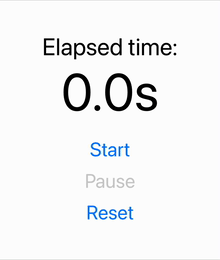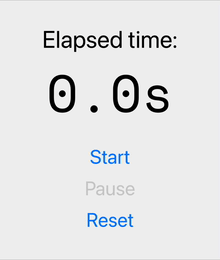January 07, 2025
Stale Callback Values in React: a Timer Example

React hooks make managing state simple and predictable. However, when state is used in a closure, such as in a callback function, problems can arise if the state value becomes "stale." This often leads to bugs that are hard to track down, especially in asynchronous contexts like timers.
But the problem of stale callback values is not limited to asynchronous operations. It can also appear in synchronous contexts such as event handlers, useCallback dependencies, and inline functions. In this blog post, we’ll use a simple timer example to explore the issue, debug it, and propose solutions. However, the lessons learnt apply to many other scenarios as well.
You can also explore the example code using Expo Snack to follow along and experiment with the solutions.
Problem: stale callback values
Stale callback values occur when a function in React "closes over" a variable, such as state or prop, but this variable is later updated. The function continues to reference the outdated value captured at the time of the closure's creation.
While this blog post focuses on a timer implemented with a useTimer hook using setInterval, the same issue can happen in many other contexts:
- Event handlers: a button click handler that references outdated state
- Memoised callbacks (
useCallback): callbacks that don't update because of missing dependencies - Inline functions: inline functions passed as props that capture stale state or props

Here’s how the issue manifests in a simple timer app
Let’s examine useTimer implementation, which tracks elapsed time and provides functions to start, pause, and reset the timer:
export const useTimer = () => {const [isRunning, setIsRunning] = useState(false);const [elapsedTime, setElapsedTime] = useState(0);useEffect(() => {if (!isRunning) return;const intervalId = setInterval(() => {setElapsedTime(elapsedTime + 0.1); // This introduces the stale state issue}, 100);return () => clearInterval(intervalId);}, [isRunning]);return { elapsedTime, isRunning, start: () => setIsRunning(true), pause: () => setIsRunning(false), reset: () => setElapsedTime(0) };};
This hook:
- tracks whether the timer is running (
isRunning) and the elapsed time (elapsedTime) - uses
setIntervalto incrementelapsedTimewhile the timer is running - provides functions to start, pause, and reset the timer
At first glance, this code seems to work as expected. But when you pause and resume the timer, the elapsed time suddenly "jumps."
The setInterval callback captures the initial value of elapsedTime when it is created. Even after elapsedTime updates, the callback continues to reference the outdated value, causing the timer to behave incorrectly.
You can try the bugged example on Snack and see it in action.
Debugging the issue
Knowing what exactly happens is half the battle.
Tracking state with logs
To understand what’s happening, let’s add a console.log inside the setInterval callback:
const intervalId = setInterval(() => {console.log("Elapsed Time:", elapsedTime);setElapsedTime(elapsedTime + 0.1);}, 100);
Running the timer reveals that elapsedTime remains constant inside the setInterval callback, even though it’s supposed to update on each tick. This happens because the callback closes over the state value at the time it was created and doesn’t get updated with new values.
Similar debugging in other contexts
The same approach can be used in other contexts, such as event handlers or inline functions, by logging the state or props captured at the time the function was created. This can help identify when a closure is causing stale values.
Possible solutions

Timer is fixed!
Solution 1: use functional state update
The simplest fix is to use the functional form of setState:
setElapsedTime(prevElapsedTime => prevElapsedTime + 0.1);
This ensures the callback always works with the most recent state value, preventing stale state issues. This approach works well not only for timers but also for event handlers or functions passed to child components.
Solution 2: Introduce useRef for elapsed time
Another approach is to use useRef to track elapsed time. Since refs are mutable and don’t cause re-renders, they can hold up-to-date value without being affected by state closure:
const elapsedTimeRef = useRef(initialElapsedTime);elapsedTimeRef.current += 0.1;setElapsedTime(elapsedTimeRef.current);
This avoids the re-renders caused by frequent state updates and ensures the timer remains accurate. useRef is also useful for managing mutable data in other scenarios, such as tracking input focus or scroll positions.
Solution 3: add elapsedTime as dependency in useEffect
Another approach is to add elapsedTime as dependency to the useEffect managing the interval:
useEffect(() => {if (!isRunning) return;const intervalId = setInterval(() => {setElapsedTime(elapsedTime + 0.1);}, 100);return () => clearInterval(intervalId);}, [isRunning, elapsedTime]);
This ensures the interval callback always uses the latest elapsedTime value but will lead to more frequent interval restarts. The same approach can be used for data-fetching hooks or animations.
Solution 4: switch to useReducer for state management
For more complex state management, useReducer centralises all state transitions into a single function:
const timerReducer = (state, action) => {switch (action.type) {case "TICK":return { ...state, elapsedTime: state.elapsedTime + 0.1 };case "START":return { ...state, isRunning: true };case "PAUSE":return { ...state, isRunning: false };case "RESET":return { elapsedTime: 0, isRunning: false };default:return state;}};const [state, dispatch] = useReducer(timerReducer, { elapsedTime: 0, isRunning: false });
This approach is robust and extensible, making it ideal for scenarios involving complex state transitions, such as forms or wizards.
Solution 5: replace polling with request animation frame (bonus)
As a bonus, you can eliminate setInterval entirely and use requestAnimationFrame for smoother and more precise updates:
const animate = (timestamp) => {const delta = (timestamp - lastTimestampRef.current) / 1000;setElapsedTime(prev => prev + delta);lastTimestampRef.current = timestamp;requestAnimationFrame(animate);};
This solution improves performance and accuracy but is slightly more advanced. It’s particularly useful for animations or tasks requiring precision, such as updating game states or UI layouts.
Summary
Stale callback values can cause subtle bugs in React, especially in asynchronous scenarios. In this article, we explored:
- what stale callback values are and why they occur
- how to debug the issue in a
useTimerimplementation and other contexts - five solutions, from simple fixes to more advanced optimizations
By understanding and addressing this problem, you can build more robust and predictable React components.
Want more?
If you liked this post, why don't you subscribe for more content? If you're as old-school as we are, you can just grab the RSS feed of this blog. Or enroll to the course described below!
Alternatively, if audio's more your thing why don't you subscribe to our podcast! We're still figuring out what it's going to be, but already quite a few episodes are waiting for you to check them out.






